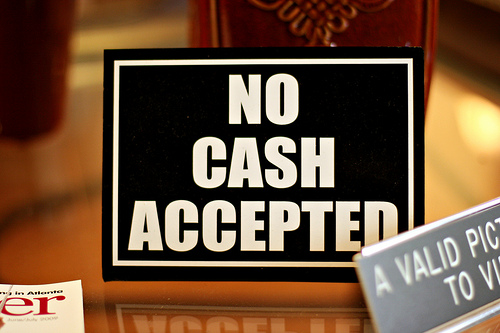What Is a CBDC? Explaining Central Bank Digital Currencies
While central bank digital currencies are not widely in use yet, they are one of the most interesting innovations in monetary economics.
Even in their infant stages of development, CBDCs have generated a whirlwind of controversy. Are they really that scary, or are they overhyped? We will unpack everything you need to know about these government-backed digital currencies.
What Are Central Bank Digital Currencies?
CBDC stands for central bank digital currency. A CBDC is electronic money officially issued by the government through its central bank. Yet the definition of a CBDC is still somewhat ambiguous and undefined.
CBDCs aren't quite the same thing as the digital balance that shows up on your bank account. But both would still be considered base money. However, the number that shows up on your bank account is a commercial deposit that essentially is created by that bank. By contrast, CBDC would be central bank money (i.e. fiat money) created directly by the government's central bank, like the paper notes and coins in circulation.
In other words, CBDCs aren't a form of credit. Nor are they a privately minted cryptocurrency that is merely denominated in the government's currency. They are fully digital versions of the currencies we use in everyday commerce. Thus they carry the same legal tender status as the cash in your wallet.

Digital currencies would eventually be used in place of cash if implemented.
Are CBDCs the Same as Cryptocurrencies?
Not exactly. There are undeniable similarities between cryptocurrencies and CBDCs. In some sense it’s reasonable to consider them government-issued cryptos.
However, there are some major differences between existing cryptocurrencies and central bank digital currencies:
- CBDCs are backed by the government, while cryptocurrencies are generally not backed by anything tangible.
- CBDCs are centrally issued (i.e. government-controlled), and most cryptocurrencies are decentralized.
- Nearly all existing cryptos use a distributed ledger known as a blockchain, but CBDCs may or may not utilize this technology.
Does the U.S. Have a CBDC?
The United States does not have an official CBDC—yet. Among other preparations, the San Francisco Fed has been researching a hypothetical U.S. CBDC.
One change to the monetary system is real-time payments (sometimes abbreviated RTP). The U.S. just recently went live with its first RTP system known as FedNow. It is an apparatus for instant payment transfers that operates 24/7. The Federal Reserve recently reported that 35 banks and credit unions are already using FedNow.
While the FedNow platform itself doesn't involve any digital currency, it does represent a step forward in the arms race for innovations and breakthroughs in controlling the future of money.
The most likely change that FedNow will usher in would be to wrest control of the payments industry away from third parties such as credit card companies and commercial banks. It may also obviate the need for ACH payments, which are essentially electronic checks.
Another related idea to a U.S. CBDC or "digital dollar" comes from the Texas Bullion Depository. The depository was established with the idea of allowing Texas and other U.S. states to store their own gold reserves, similar to how the federal government does at Fort Knox, Kentucky. Now, the Texas Bullion Depository has plans to issue a digital currency backed by its precious metals in storage.
Other Countries Developing Central Bank Digital Currencies
While this technology is a long way from being mainstream, about a dozen countries internationally have already issued their own CBDCs. They are located primarily in the Caribbean, such as Jamaica and the Bahamas, but the trend is rapidly spreading around the world. Both the Bank of Japan and the Bank of England, among others, announced their intentions to establish digital payments with a digital yen and digital pound, respectively.
Chinese president Xi Jinping has stated that establishing a CBDC would be an important development in China's Belt & Road Initiative. Moreover, the Bank for International Settlements (BIS) recently released a report outlining its own plan for CBDCs.
A recent survey conducted by the BIS showed that 93% of central banks are working on digital currencies. In total, over 100 nations are exploring the issuance of CBDCs right now. It is estimated that about two dozen different central banks could have their own CBDC by the year 2030.
Here is a rundown of other notable countries that are planning or in the process of rolling out CBDCs soon:
- China (digital yuan)
- India
- Switzerland
- Brazil
- Australia
- U.K.
- European Union (EU)
- United Arab Emirates (UAE)
- Nigeria (eNaira)
How CBDCs Work
While a CBDC may or may not utilize a blockchain like traditional cryptocurrencies, it would somewhat similarly represent a "tokenization" of the money supply. In theory, virtually any type of asset can be tokenized.
In practice a digital currency can function as a wholesale CBDC or a retail CBDC. With a wholesale CBDC, the government distributes the tokens to third-party intermediaries, such as financial institutions. A retail CBDC, by contrast, would give an individual direct access to an account at the central bank where the tokens are held.
Tokenizing a country’s money supply could have a number of interesting benefits compared to current payment systems. It could also have some worrying drawbacks, which we’ll discuss in the next section.
CBDCs could quite easily subsume some of the noble goals of existing private cryptocurrencies:
- creating greater access to financing to the poor (financial inclusion)
- providing banking services to the previously unbanked
- facilitating smoother cross-border money flows and interbank transfers
- reducing the time and cost constraints of transferring money
- incorporating automation to make calculating and paying taxes much easier
Moreover, governments could centralize heaps of economic data and behavioral data of consumers. This data would then inform monetary and fiscal policy. Looking toward the future, that technical feasibility might even be a step toward solving the stubborn "measurement problem" in economics.
Potential Problems With CBDCs
Despite all of the proposed use cases for central bank electronic money, some of the capabilities of CBDCs do offer the alarming potential for excessive surveillance and censorship.
Up to now my main criticism of CBDCs is that they centralize every aspect of the money supply. Imagine having every single transaction you make monitored, tracked, and potentially censored at the whim of policymakers. It raises clear privacy concerns.
We have already seen the beginnings of this issue with the People's Bank of China. All financial activity can be centrally monitored, and consumers may be denied certain rights and freedoms based on how the government views their purchasing decisions. This presents a threat to liberty and would fit well in dystopian fiction—except it's becoming a reality.
I've heard this situation described as a "techno-feudalism": your ability to freely use and grow your money is unavoidably curtailed. It could also lead to the elimination of physical cash in the interest of creating a fully digital currency, as we have seen with the demonetization of banknotes in India. One member of the European Parliament from Germany has called it "a solution in search of a problem."
Public Reaction to CBDC Introduction
For the most part, public sentiment regarding CBDCs has vacillated between skeptical to indifferent.
You have on the one hand a poll conducted last month by The Ron Paul Institute for Peace and Prosperity that indicated a majority of Americans are not in favor of a central bank digital currency. Another poll carried out by Kings College in London found a fairly equal split between people who think CBDCs are part of a nefarious government conspiracy and those who rejected such an idea.
On the other hand, roughly half of respondents to a survey conducted by the Cato Institute revealed they were indifferent to the notion of a monetary system based on a CBDC. Perhaps digital currencies are not that big of a deal in the public's opinion—at least not yet.
It is undeniable that CBDCs will inescapably be a political talking point in the coming decade. Greater public awareness of the issue will be needed to ensure that an informed discussion takes place.
Read more about developments in the global economy from the authors at Gainesville Coins:
The Shanghai International Gold Exchange and Its Role in De-Dollarization
COMEX Gold Futures Explained Part 1: The Basics
Gold And Silver Premiums Guide: How Bullion Premiums Work
Investor Resources for Understanding Gold, Silver, and Precious Metals
How a Central Bank in the Caribbean Recently Used Its Gold Revaluation Account to Cover Losses

Everett Millman
Everett has been the head content writer and market analyst at Gainesville Coins since 2013. He has a background in History and is deeply interested in how gold and silver have historically fit into the financial system.
In addition to blogging, Everett's work has been featured in Reuters, CNN Business, Bloomberg Radio, TD Ameritrade Network, CoinWeek, and has been referenced by the Washington Post.
